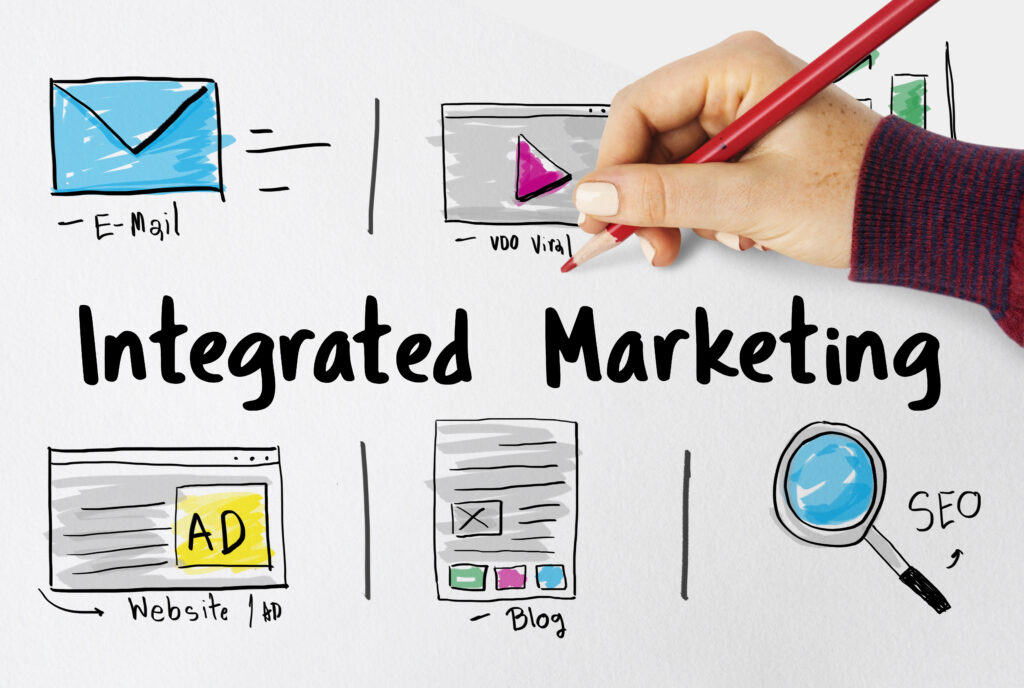
A Charlotte FCMO’s Guide to Consistent Messaging in Marketing
Running a business is more than just selling a product. It’s also about connecting with audiences and helping them with specific problems: Part of that involves crafting a personal and consistent message.
Consistency is key when crafting a message. Even the slightest change in tone or posting on the wrong platform can change the meaning of a message.
If your business is in a competitive environment like Charlotte, hiring a fractional CMO is a smart way to stand out. Their expertise in branding is a great asset in conveying consistent and brand-specific messages.
Continue reading to learn more from a Charlotte FCMO on message consistency and integrated marketing and here's Jason with more, too!
What Is Integrated Marketing for Consistent Messaging?
Integrated marketing is creating a unified message across multiple marketing channels. It’s a combination of tactical and strategic marketing that allows businesses to showcase a cohesive image of their brand, which ultimately leads to more leads and campaign success.
Marketing is all about connecting with the audience, and integrated marketing is a way to build trust and credibility. It gives the audience a consistent experience of your brand, regardless of how they choose to interact with it.
What Is Consistency in Marketing Messaging?
Consistency in brand messaging involves using the same language and tone of voice to express an idea in many ways. It makes it easier for people to understand your brand and its values, increasing potential leads and engagement. A consistent message across all platforms makes your brand more memorable and noticeable.
What Are the 4 C’s of Integrated Marketing?
Integrated marketing can easily be achieved by following the four C’s. These are guidelines that strengthen integrated marketing efforts and (help) ensure success.
The four C’s of marketing are:
- Consistency: An integrated marketing campaign should have the same look and feel across all platforms.
- Coherence: A campaign should deliver a coherent message.
- Complementary: Every part of a campaign should work well together and contribute to the bigger picture.
- Continuity: A good integrated marketing campaign flows naturally and tells one cohesive story.
What Are the Best Examples of Brand Consistency?
When done correctly, consistent brand marketing can transform your business. Here at Digital Authority Partners, we used consistent messaging to help one of our clients achieve a significant boost in qualified leads and traffic.
Our client, DecisionLink, struggled with securing new customers — both conversion rates and traffic were low. Our solution was a fresh rebranding strategy that consisted of simplified messages, emphasis on the brand’s USP, and content adjusted based on audience market segmentation.
With a fresh and consistent brand image and highlighting their unique selling points, the brand saw a huge increase of 200% in lead quality and a 178% jump in traffic.

How To Achieve Message Consistency For Integrated Marketing
With the help of a Charlotte FCMO for message consistency and integrated marketing, you can achieve consistent messaging that aligns with your brand’s values and attracts new customers.
Follow these tips to get started.
1. Write a Brand Guide
Creating a consistent message starts with getting to know your own brand and a brand style guide is a great way to do that. Think of this style guide as a brand handbook that outlines all important elements needed to achieve brand consistency.
The purpose of this guide is to serve as a reference for the brand’s overall look and feel, which includes both visual and non-visual elements, such as:
- Logos
- Colors
- Fonts
- Typography
- Tone of voice
- Language
- Key selling points
- Brand values
This guide is the foundation for all branding and messaging efforts. Everything you convey must align with what’s in this guide. A Charlotte FCMO for message consistency and integrated marketing helps you create this brand guide by finding answers to questions like:
- What is our brand’s unique selling proposition?
- What kind of image do we want our brand to convey?
- What distinct elements can we show in our branding?
Figuring out the answers to these questions gives you a clearer idea of your brand’s identity and what direction to take in terms of conveying your message.
2. Make a Messaging Matrix
Consistent communication on multiple platforms can be difficult to keep track of, which is why having a messaging matrix is vital. A messaging matrix is a tool used to manage and streamline all communications in a company.
This is a handy tool to have in your marketing strategy since it makes it easier to keep all messages across all different platforms true to the brand’s values and mission.
A messaging matrix has several components that all play a role in conveying effective messages and ensuring brand consistency. The essential elements are:
- Brand positioning
- Main benefits
- Target audience segments
- Buyer personas
- Messaging guidelines
- Style guidelines
3. Establish and Follow a Clear Process
From coming up with ideas in the board room to launching them on digital or traditional platforms, maintaining consistency is dependent on a clear, well-thought-out process. This is where a Charlotte FCMO for message consistency and integrated marketing comes in clutch.
A clear, step-by-step process serves as the foundation of an entire strategy. It also keeps everyone on the same page and ensures that all efforts align with the company’s goals.
A general workflow for creating consistent brand messaging may look something like this:
- Defining the brand’s core values and guidelines
- Creating messaging guidelines
- Competitor and market research
- Message development
- Alignment across different platforms
- Results tracking and reporting
There are also a handful of tools to use that streamline processes and provide you with more information on how to improve your messaging campaign. These include:
- Digital asset management tools
- CRM software
- Local market analytics tools
- Project management tools
5. Create an Organizational Chart
An organizational chart (also called an org chart or O-chart) is a visual representation of your company’s structure. It highlights the hierarchy and roles of each person in the team so everyone knows what they do and who to go for when they have questions.
How this helps with message consistency is that each team member is given a clear role, such as creative, copywriter, social media manager, and so on. All members make use of their strengths and work harmoniously to create a unified message.
An org chart is useful for growing companies and startups that have fewer clearly defined roles. This chart can give more clarity into everyone’s responsibilities and improve overall efficiency and collaboration.
Start making your chart by assessing everyone in the team and taking note of their strengths and weaknesses. Identify their skill set and what position fits them best. This also establishes clear ownership and accountability for messaging across all departments.
Creating a tiger team is another helpful tip. A tiger team consists of several members from many departments to address urgent issues or larger-scale problems that require specialized skills. (Fun fact: The term “tiger team” got its start in Nasa!)
6. Train Your Team
Having a well-trained team is another crucial aspect of flawless brand messages. Your team members are essentially the company's spokespersons; it's part of their jobs to represent the company well with their messages.
One of the first steps to training your team is by introducing the company. Here’s where you reiterate the brand's values to give your team a clear idea of what kind of messages to create. A Charlotte FCMO can also train employees on different marketing methods and channels.
It’s also helpful to share all valuable information and resources about your brand. This includes your branding guidelines, references, software, and other useful tools.
Another vital part of training is providing feedback. Your employees may not get everything right the first time, and that's okay! As a leader, it's important to point out your team's strengths and weaknesses and offer ways to improve.
7. Meet Regularly and Collaborate
Consistency in marketing messages is never a one-person job. It's a process that uses a marketing team’s collaborative efforts and strengths to create positive results. It’s crucial that teams meet regularly.
Schedule weekly or monthly meetings with the teams to coordinate with each other more easily and keep everyone on the same page. Doing so also promotes transparency and open communication, which are crucial in the marketing process.
Meetings also open the door for feedback and fresh perspectives that can boost the effectiveness of the campaign. Use this time to open the floor for questions and concerns so they may be addressed as a team.
It’s also beneficial to collaborate with other departments, such as social media and web design, so all parts of the campaign are optimized. It also helps maintain consistency, proper timing, and execution of messaging campaigns.
Establish a Marketing Workflow
When it comes to consistency in your messages, the last thing you want is confusion. This can be avoided if you follow a structured marketing workflow that flows smoothly with as few bottlenecks as possible. Having a nice structured process helps prevent disorganization so that every part of your messaging campaigns falls into the right places.
Creating a marketing workflow involves establishing clear goals and KPIs and coordinating across departments so these goals are met. Going back to your brand and messaging guidelines also ensures that your messages are conveyed in accordance with these guidelines.
Part of creating a structured workflow is also pulling out different tools to increase speed and efficiency. Some of these may include:
- CRM software
- Data analytics tools
- Project management tools
- Communication platforms
Track and Measure Campaign Results
The brand messaging process doesn’t end after releasing your campaign or ad. It’s a type of data-driven marketing that requires careful monitoring and analysis.
One of the most major steps is going back to your previously set goals and KPIs. KPIs and goals share objective insights into the success of your campaign.
Together with your FCMO, monitor your campaign’s results and identify areas for improvement. It’d be helpful to use a variety of tools (like Google Analytics for one) to monitor metrics such as:
- Conversion rate
- Click-through rate
- Bounce rate
- Engagement rate
- … and put it all together to find your return on investment
Meet With a Charlotte FCMO About Your Company’s Messaging
A brand’s message is one of the most powerful assets of your business. With the right consistency and tactics to convey your message, your brand could remain in the minds of both current and new customers.
If you’re in the process of crafting your message, you can seek the help of a Charlotte FCMO for message consistency and integrated marketing. Our team of expert fractional marketers here at Digital Authority Partners is ready to transform your brand’s message into one that resonates with audiences.
Whether you hire a fractional CMO for eCommerce brands or a fractional CMO for SaaS, no industry is too complex for us to handle.
Let’s talk more about how our Charlotte team can make messaging magic — set up a time to talk today!
Want To Meet Our Expert Team?
Book a meeting directly here




